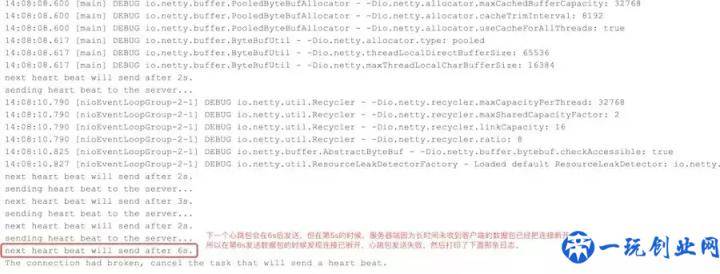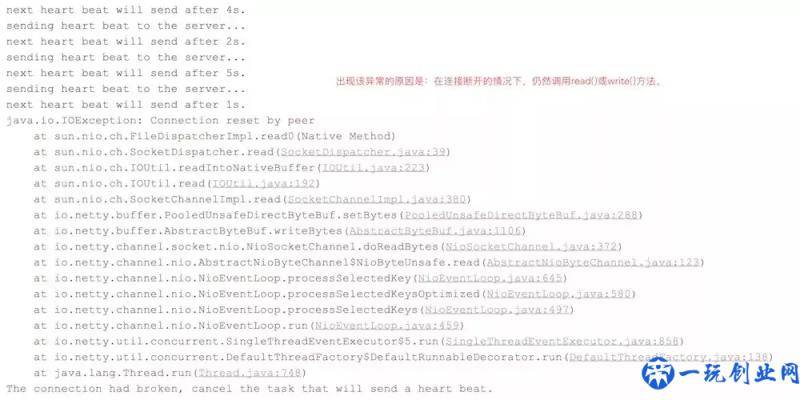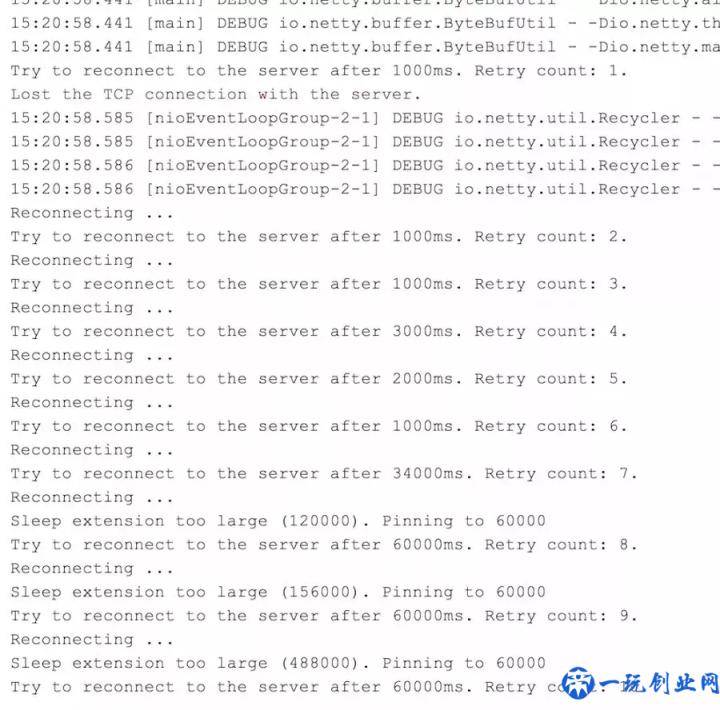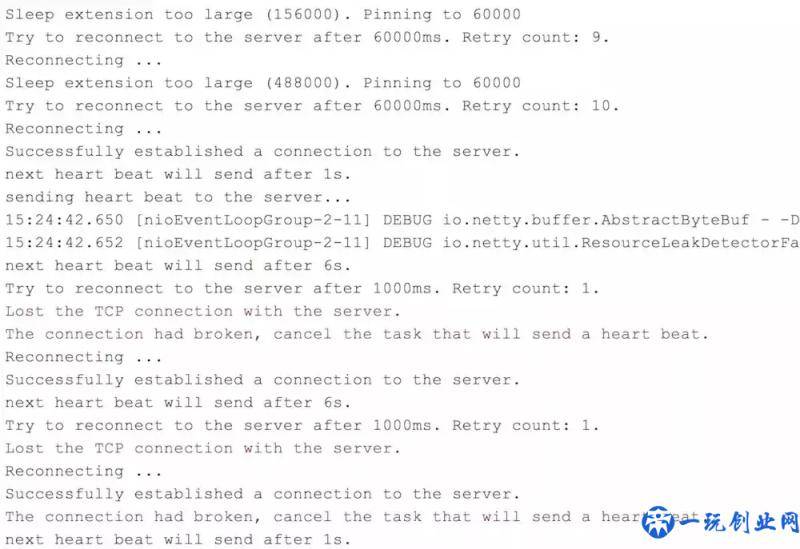心跳体制
什么是心跳
所说心跳, 即在 TCP 长连接中, 手机客户端和服务器进行按时发送的一种特有的数据, 通告别人自身还线上, 以保证 TCP 联接的实效性.
注:心跳包也有另一个功效,常常被忽视,即:一个联接假如长期不用,服务器防火墙或是无线路由器便会断掉该联接。
怎样完成
关键Handler —— IdleStateHandler
在 Netty 中, 完成心跳体制的关键是 IdleStateHandler, 那麼这一 Handler 怎么使用呢? 首先看下它的构造器:
public IdleStateHandler(int readerIdleTimeSeconds, int writerIdleTimeSeconds, int allIdleTimeSeconds) {
this((long)readerIdleTimeSeconds, (long)writerIdleTimeSeconds, (long)allIdleTimeSeconds, TimeUnit.SECONDS);
}
这儿表述下三个主要参数的含意:
- readerIdleTimeSeconds: 读请求超时. 即如在指定的时间间隔内沒有从 Channel 载入到数据信息时, 会激发一个 READER_IDLE 的 IdleStateEvent 事件.
- writerIdleTimeSeconds: 写请求超时. 即如在指定的时间间隔内沒有数据信息载入到 Channel 时, 会激发一个 WRITER_IDLE 的 IdleStateEvent 事件.
- allIdleTimeSeconds: 读/写请求超时. 即如在指定的时间间隔内沒有读或写实际操作时, 会激发一个ALL_IDLE 的 IdleStateEvent 事件.
注:这三个主要参数默认设置的时间单位是秒。若必须指定别的时间单位,可以应用另一个构造函数:IdleStateHandler(boolean observeOutput, long readerIdleTime, long writerIdleTime, long allIdleTime, TimeUnit unit)
在看下面的完成以前,提议先了解一下IdleStateHandler的建立基本原理。
下边立即上编码,必须留意的地区,会在源代码中根据注解开展表明。
应用IdleStateHandler完成心跳
下边将应用IdleStateHandler来完成心跳,Client端接入到Server端后,会循环系统实行一个每日任务:任意等候几秒,随后ping一下Server端,即发送一个心跳包。当等待时间超出規定時间,可能发送不成功,认为Server端在这之前已经积极断开了。编码如下所示:
Client端
ClientIdleStateTrigger —— 心跳触发器原理
类ClientIdleStateTrigger也是一个Handler,仅仅重新写过了userEventTriggered方式,用以捕获IdleState.WRITER_IDLE事件(未在指定時间内向型网络服务器发送数据信息),随后向Server端发送一个心跳包。
/**
* <p>
* 用以捕获{@link IdleState#WRITER_IDLE}事件(未在指定時间内向型网络服务器发送数据信息),随后向<code>Server</code>端发送一个心跳包。
* </p>
*/
public class ClientIdleStateTrigger extends ChannelInboundHandlerAdapter {
public static final String HEART_BEAT = \"heart beat!\";
@Override
public void userEventTriggered(ChannelHandlerContext ctx, Object evt) throws Exception {
if (evt instanceof IdleStateEvent) {
IdleState state = ((IdleStateEvent) evt).state();
if (state == IdleState.WRITER_IDLE) {
// write heartbeat to server
ctx.writeAndFlush(HEART_BEAT);
}
} else {
super.userEventTriggered(ctx, evt);
}
}
}
Pinger —— 心跳发射装置
/**
* <p>手机客户端联接到服务端后,会循环系统实行一个每日任务:任意等候几秒,随后ping一下Server端,即发送一个心跳包。</p>
*/
public class Pinger extends ChannelInboundHandlerAdapter {
private Random random = new Random();
private int baseRandom = 8;
private Channel channel;
@Override
public void channelActive(ChannelHandlerContext ctx) throws Exception {
super.channelActive(ctx);
this.channel = ctx.channel();
ping(ctx.channel());
}
private void ping(Channel channel) {
int second = Math.max(1, random.nextInt(baseRandom));
System.out.println(\"next heart beat will send after \" second \"s.\");
ScheduledFuture<?> future = channel.eventLoop().schedule(new Runnable() {
@Override
public void run() {
if (channel.isActive()) {
System.out.println(\"sending heart beat to the server...\");
channel.writeAndFlush(ClientIdleStateTrigger.HEART_BEAT);
} else {
System.err.println(\"The connection had broken, cancel the task that will send a heart beat.\");
channel.closeFuture();
throw new RuntimeException();
}
}
}, second, TimeUnit.SECONDS);
future.addListener(new GenericFutureListener() {
@Override
public void operationComplete(Future future) throws Exception {
if (future.isSuccess()) {
ping(channel);
}
}
});
}
@Override
public void exceptionCaught(ChannelHandlerContext ctx, Throwable cause) throws Exception {
// 当Channel已经中断的情形下, 依然发送数据信息, 会抛出现异常, 该方式会被启用.
cause.printStackTrace();
ctx.close();
}
}
ClientHandlersInitializer —— 手机客户端CPU结合的复位类
public class ClientHandlersInitializer extends ChannelInitializer<SocketChannel> {
private ReconnectHandler reconnectHandler;
private EchoHandler echoHandler;
public ClientHandlersInitializer(TcpClient tcpClient) {
Assert.notNull(tcpClient, \"TcpClient can not be null.\");
this.reconnectHandler = new ReconnectHandler(tcpClient);
this.echoHandler = new EchoHandler();
}
@Override
protected void initChannel(SocketChannel ch) throws Exception {
ChannelPipeline pipeline = ch.pipeline();
pipeline.addLast(new LengthFieldBasedFrameDecoder(Integer.MAX_VALUE, 0, 4, 0, 4));
pipeline.addLast(new LengthFieldPrepender(4));
pipeline.addLast(new StringDecoder(CharsetUtil.UTF_8));
pipeline.addLast(new StringEncoder(CharsetUtil.UTF_8));
pipeline.addLast(new Pinger());
}
}
注: 上边的Handler结合,除开Pinger,别的全是转码软件和处理粘包,可以忽视。
TcpClient —— TCP联接的手机客户端
public class TcpClient {
private String host;
private int port;
private Bootstrap bootstrap;
/** 将<code>Channel</code>保存, 可用来在别的非handler的地区传送数据 */
private Channel channel;
public TcpClient(String host, int port) {
this(host, port, new ExponentialBackOffRetry(1000, Integer.MAX_VALUE, 60 * 1000));
}
public TcpClient(String host, int port, RetryPolicy retryPolicy) {
this.host = host;
this.port = port;
init();
}
/**
* 向远程控制TCP网络服务器要求联接
*/
public void connect() {
synchronized (bootstrap) {
ChannelFuture future = bootstrap.connect(host, port);
this.channel = future.channel();
}
}
private void init() {
EventLoopGroup group = new NioEventLoopGroup();
// bootstrap 可器重, 只需在TcpClient创建对象的情况下复位就可以.
bootstrap = new Bootstrap();
bootstrap.group(group)
.channel(NioSocketChannel.class)
.handler(new ClientHandlersInitializer(TcpClient.this));
}
public static void main(String[] args) {
TcpClient tcpClient = new TcpClient(\"localhost\", 2222);
tcpClient.connect();
}
}
Server端
ServerIdleStateTrigger —— 断连触发器原理
/**
* <p>在要求时间段内未接到服务端的一切数据, 将积极断掉该联接</p>
*/
public class ServerIdleStateTrigger extends ChannelInboundHandlerAdapter {
@Override
public void userEventTriggered(ChannelHandlerContext ctx, Object evt) throws Exception {
if (evt instanceof IdleStateEvent) {
IdleState state = ((IdleStateEvent) evt).state();
if (state == IdleState.READER_IDLE) {
// 在要求时间段内没接到服务端的上涨数据信息, 积极断开
ctx.disconnect();
}
} else {
super.userEventTriggered(ctx, evt);
}
}
}
ServerBizHandler —— 服务端的业务流程CPU
/**
* <p>接到来源于手机客户端的数据后, 立即在控制面板打印出出去.</p>
*/
@ChannelHandler.Sharable
public class ServerBizHandler extends SimpleChannelInboundHandler<String> {
private final String REC_HEART_BEAT = \"I had received the heart beat!\";
@Override
protected void channelRead0(ChannelHandlerContext ctx, String data) throws Exception {
try {
System.out.println(\"receive data: \" data);
// ctx.writeAndFlush(REC_HEART_BEAT);
} catch (Exception e) {
e.printStackTrace();
}
}
@Override
public void channelActive(ChannelHandlerContext ctx) throws Exception {
System.out.println(\"Established connection with the remote client.\");
// do something
ctx.fireChannelActive();
}
@Override
public void channelInactive(ChannelHandlerContext ctx) throws Exception {
System.out.println(\"Disconnected with the remote client.\");
// do something
ctx.fireChannelInactive();
}
@Override
public void exceptionCaught(ChannelHandlerContext ctx, Throwable cause) throws Exception {
cause.printStackTrace();
ctx.close();
}
}
ServerHandlerInitializer —— 服务端CPU结合的复位类
/**
* <p>用以复位服务端牵涉到的全部<code>Handler</code></p>
*/
public class ServerHandlerInitializer extends ChannelInitializer<SocketChannel> {
protected void initChannel(SocketChannel ch) throws Exception {
ch.pipeline().addLast(\"idleStateHandler\", new IdleStateHandler(5, 0, 0));
ch.pipeline().addLast(\"idleStateTrigger\", new ServerIdleStateTrigger());
ch.pipeline().addLast(\"frameDecoder\", new LengthFieldBasedFrameDecoder(Integer.MAX_VALUE, 0, 4, 0, 4));
ch.pipeline().addLast(\"frameEncoder\", new LengthFieldPrepender(4));
ch.pipeline().addLast(\"decoder\", new StringDecoder());
ch.pipeline().addLast(\"encoder\", new StringEncoder());
ch.pipeline().addLast(\"bizHandler\", new ServerBizHandler());
}
}
注:new IdleStateHandler(5, 0, 0)该handler意味着假如在5秒内没得到来源于手机客户端的一切数据(包含但是不限于心跳包),可能积极断掉与该手机客户端的联接。
TcpServer —— 服务端
public class TcpServer {
private int port;
private ServerHandlerInitializer serverHandlerInitializer;
public TcpServer(int port) {
this.port = port;
this.serverHandlerInitializer = new ServerHandlerInitializer();
}
public void start() {
EventLoopGroup bossGroup = new NioEventLoopGroup(1);
EventLoopGroup workerGroup = new NioEventLoopGroup();
try {
ServerBootstrap bootstrap = new ServerBootstrap();
bootstrap.group(bossGroup, workerGroup)
.channel(NioServerSocketChannel.class)
.childHandler(this.serverHandlerInitializer);
// 关联端口号,逐渐接受进去的联接
ChannelFuture future = bootstrap.bind(port).sync();
System.out.println(\"Server start listen at \" port);
future.channel().closeFuture().sync();
} catch (Exception e) {
bossGroup.shutdownGracefully();
workerGroup.shutdownGracefully();
e.printStackTrace();
}
}
public static void main(String[] args) throws Exception {
int port = 2222;
new TcpServer(port).start();
}
}
至此,全部编码已经撰写结束。
检测
最先运行手机客户端,重新启动服务端。运行进行后,在手机客户端的操纵台子上,能够看见打印出如下所示相近日志:

手机客户端控制面板輸出的日志
在服务端能够看见控制面板輸出了相近如下的日志:

服务器端控制面板輸出的日志
能够看见,客户端在发送4个心跳包后,第5个包由于等待的时间较长,直到真真正正发送的情况下,发觉连接已断开了;而服务器端接到客户端的4个心率数据后,一直等不到下一个数据,因此坚决断开该连接。
异常现象
在检测环节中,有可能会产生如下所示状况:

异常现象
发生这种现象的因素是:在连接已断开的情形下,依然向服务器端发送心跳包。尽管在发送心跳包以前会应用channel.isActive()分辨连接是不是可以用,但也是有很有可能上一刻分辨結果为可以用,但下一刻发送数据以前,连接就断掉。
现阶段并未寻找雅致解决这样的情况的计划方案,各位看官如果有好的解决方法,还望鼎力相助。叩谢!!!
断线重新连接
断线重连这儿就但是多详细介绍,坚信诸位都了解是什么原因。这儿只说大概构思,随后立即上编码。
完成构思
客户端在检测到与服务器端的连接断开后,或是一开始就没法连接的情形下,应用特定的重新连接对策开展重新连接实际操作,直到再次创建连接或再试频次耗光。
针对怎样检测连接是不是断开,则是根据重新写过ChannelInboundHandler#channelInactive来完成,但连接不能用,该方式会被开启,因此只要在该方式搞好重新连接工作中就可以。
编码完成
注:下列编码全是在上面心率体制的基本上改动/加上的。
由于断线重新连接是客户端的工作中,因此只需对客户端编码开展改动。
再试对策
RetryPolicy —— 再试对策插口
public interface RetryPolicy {
/**
* Called when an operation has failed for some reason. This method should return
* true to make another attempt.
*
* @param retryCount the number of times retried so far (0 the first time)
* @return true/false
*/
boolean allowRetry(int retryCount);
/**
* get sleep time in ms of current retry count.
*
* @param retryCount current retry count
* @return the time to sleep
*/
long getSleepTimeMs(int retryCount);
}
ExponentialBackOffRetry —— 重新连接对策的默认设置完成
/**
* <p>Retry policy that retries a set number of times with increasing sleep time between retries</p>
*/
public class ExponentialBackOffRetry implements RetryPolicy {
private static final int MAX_RETRIES_LIMIT = 29;
private static final int DEFAULT_MAX_SLEEP_MS = Integer.MAX_VALUE;
private final Random random = new Random();
private final long baseSleepTimeMs;
private final int maxRetries;
private final int maxSleepMs;
public ExponentialBackOffRetry(int baseSleepTimeMs, int maxRetries) {
this(baseSleepTimeMs, maxRetries, DEFAULT_MAX_SLEEP_MS);
}
public ExponentialBackOffRetry(int baseSleepTimeMs, int maxRetries, int maxSleepMs) {
this.maxRetries = maxRetries;
this.baseSleepTimeMs = baseSleepTimeMs;
this.maxSleepMs = maxSleepMs;
}
@Override
public boolean allowRetry(int retryCount) {
if (retryCount < maxRetries) {
return true;
}
return false;
}
@Override
public long getSleepTimeMs(int retryCount) {
if (retryCount < 0) {
throw new IllegalArgumentException(\"retries count must greater than 0.\");
}
if (retryCount > MAX_RETRIES_LIMIT) {
System.out.println(String.format(\"maxRetries too large (%d). Pinning to %d\", maxRetries, MAX_RETRIES_LIMIT));
retryCount = MAX_RETRIES_LIMIT;
}
long sleepMs = baseSleepTimeMs * Math.max(1, random.nextInt(1 << retryCount));
if (sleepMs > maxSleepMs) {
System.out.println(String.format(\"Sleep extension too large (%d). Pinning to %d\", sleepMs, maxSleepMs));
sleepMs = maxSleepMs;
}
return sleepMs;
}
}
ReconnectHandler—— 重新连接CPU
@ChannelHandler.Sharable
public class ReconnectHandler extends ChannelInboundHandlerAdapter {
private int retries = 0;
private RetryPolicy retryPolicy;
private TcpClient tcpClient;
public ReconnectHandler(TcpClient tcpClient) {
this.tcpClient = tcpClient;
}
@Override
public void channelActive(ChannelHandlerContext ctx) throws Exception {
System.out.println(\"Successfully established a connection to the server.\");
retries = 0;
ctx.fireChannelActive();
}
@Override
public void channelInactive(ChannelHandlerContext ctx) throws Exception {
if (retries == 0) {
System.err.println(\"Lost the TCP connection with the server.\");
ctx.close();
}
boolean allowRetry = getRetryPolicy().allowRetry(retries);
if (allowRetry) {
long sleepTimeMs = getRetryPolicy().getSleepTimeMs(retries);
System.out.println(String.format(\"Try to reconnect to the server after %dms. Retry count: %d.\", sleepTimeMs, retries));
final EventLoop eventLoop = ctx.channel().eventLoop();
eventLoop.schedule(() -> {
System.out.println(\"Reconnecting ...\");
tcpClient.connect();
}, sleepTimeMs, TimeUnit.MILLISECONDS);
}
ctx.fireChannelInactive();
}
private RetryPolicy getRetryPolicy() {
if (this.retryPolicy == null) {
this.retryPolicy = tcpClient.getRetryPolicy();
}
return this.retryPolicy;
}
}
ClientHandlersInitializer
在以前的基本上,加上了重新连接CPUReconnectHandler。
public class ClientHandlersInitializer extends ChannelInitializer<SocketChannel> {
private ReconnectHandler reconnectHandler;
private EchoHandler echoHandler;
public ClientHandlersInitializer(TcpClient tcpClient) {
Assert.notNull(tcpClient, \"TcpClient can not be null.\");
this.reconnectHandler = new ReconnectHandler(tcpClient);
this.echoHandler = new EchoHandler();
}
@Override
protected void initChannel(SocketChannel ch) throws Exception {
ChannelPipeline pipeline = ch.pipeline();
pipeline.addLast(this.reconnectHandler);
pipeline.addLast(new LengthFieldBasedFrameDecoder(Integer.MAX_VALUE, 0, 4, 0, 4));
pipeline.addLast(new LengthFieldPrepender(4));
pipeline.addLast(new StringDecoder(CharsetUtil.UTF_8));
pipeline.addLast(new StringEncoder(CharsetUtil.UTF_8));
pipeline.addLast(new Pinger());
}
}
TcpClient
在以前的基础上添加重新连接、重连策略的支持。
public class TcpClient {
private String host;
private int port;
private Bootstrap bootstrap;
/** 重新连接策略 */
private RetryPolicy retryPolicy;
/** 将<code>Channel</code>保存, 可用来在别的非handler的地区传送数据 */
private Channel channel;
public TcpClient(String host, int port) {
this(host, port, new ExponentialBackOffRetry(1000, Integer.MAX_VALUE, 60 * 1000));
}
public TcpClient(String host, int port, RetryPolicy retryPolicy) {
this.host = host;
this.port = port;
this.retryPolicy = retryPolicy;
init();
}
/**
* 向远程控制TCP网络服务器要求联接
*/
public void connect() {
synchronized (bootstrap) {
ChannelFuture future = bootstrap.connect(host, port);
future.addListener(getConnectionListener());
this.channel = future.channel();
}
}
public RetryPolicy getRetryPolicy() {
return retryPolicy;
}
private void init() {
EventLoopGroup group = new NioEventLoopGroup();
// bootstrap 可器重, 只需在TcpClient创建对象的情况下复位就可以.
bootstrap = new Bootstrap();
bootstrap.group(group)
.channel(NioSocketChannel.class)
.handler(new ClientHandlersInitializer(TcpClient.this));
}
private ChannelFutureListener getConnectionListener() {
return new ChannelFutureListener() {
@Override
public void operationComplete(ChannelFuture future) throws Exception {
if (!future.isSuccess()) {
future.channel().pipeline().fireChannelInactive();
}
}
};
}
public static void main(String[] args) {
TcpClient tcpClient = new TcpClient(\"localhost\", 2222);
tcpClient.connect();
}
}
检测
在测试以前,为了更好地绕开 Connection reset by peer 出现异常,可以略微改动Pinger的ping()方式,添加if (second == 5)的标准分辨。如下所示:
private void ping(Channel channel) {
int second = Math.max(1, random.nextInt(baseRandom));
if (second == 5) {
second = 6;
}
System.out.println(\"next heart beat will send after \" second \"s.\");
ScheduledFuture<?> future = channel.eventLoop().schedule(new Runnable() {
@Override
public void run() {
if (channel.isActive()) {
System.out.println(\"sending heart beat to the server...\");
channel.writeAndFlush(ClientIdleStateTrigger.HEART_BEAT);
} else {
System.err.println(\"The connection had broken, cancel the task that will send a heart beat.\");
channel.closeFuture();
throw new RuntimeException();
}
}
}, second, TimeUnit.SECONDS);
future.addListener(new GenericFutureListener() {
@Override
public void operationComplete(Future future) throws Exception {
if (future.isSuccess()) {
ping(channel);
}
}
});
}
运行手机客户端
先只运行手机客户端,观查控制面板輸出,能够看见相近如下所示日志:

断开重新连接检测——手机客户端控制面板輸出
能够看见,当手机客户端发觉无法连接到服务端,因此一直试着重新连接。伴随着再试频次提升,再试间隔时间越大,但又不愿无尽扩大下来,因此必须定一个阀值,例如60s。如上图所述所显示,时下一次再试時间超出60s时,会打印出Sleep extension too large(*). Pinning to 60000,企业为ms。发生这样的话的意思是,推算出来的时长超出阀值(60s),因此把真真正正睡眠质量的时间重置为阀值(60s)。
运行服务端
然后运行服务端,随后再次观查手机客户端控制面板輸出。

断开重新连接检测——服务端运行后手机客户端控制面板輸出
能够看见,在第9次再试不成功后,第10次再试以前,运行的网络服务器,因此第10次重新连接的效果为Successfully established a connection to the server.,即取得成功联接到网络服务器。下面由于或是不按时ping网络服务器,因此发生断开重新连接、断开重新连接的循环系统。
版权声明:本文内容由互联网用户自发贡献,该文观点仅代表作者本人。本站仅提供信息存储空间服务,不拥有所有权,不承担相关法律责任。如发现本站有涉嫌抄袭侵权/违法违规的内容, 请发送邮件至 举报,一经查实,本站将立刻删除。


